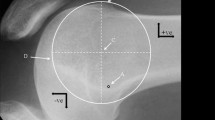Abstract
Purpose
Predisposing factors to objective patellar instability include trochlear dysplasia, patella alta, patellar tilt and elevated tibial tuberosity–femoral groove distance. The shape of the patella is classically not considered a predisposing factor. Anomalies of dynamic and static factors, including excessive patellar height, tibial tubercle lateralisation or trochlear dysplasia, may influence the development of the patella.
Methods
One hundred and five patients (140 knees) with objective patellar instability were retrospectively reviewed to identify a possible association between the above-mentioned predisposing factors and patellar shape. All patients were evaluated with static and dynamic CT scans, and plain lateral and antero-posterior radiographs, and skyline patellar views.
Results
Evidence of a significant association emerged between patellar shape and patellar tilt in static (r s = 0.20, P = 0.019) or dynamic conditions (r s = 0.18, P = 0.031) and a significant association between Wiberg patellar shape type C and trochlear dysplasia grade 3 (χ2 = 4.5, P = 0.035). Also, we found a significant association between trochlear dysplasia stage 3 and tibial tuberosity–trochlear groove (TT–TG) and patellar tilt relaxed (P < 0.01 and P < 0.05, respectively). There is an association between patellar shape and patellar tilt.
Conclusion
Increased lateral stresses may produce a Wiberg type C patella, with a hypoplastic medial facet and a more developed lateral facet. Unbalance between dynamic medial and lateral stabilisers may act as an additional factor. A rehabilitation program aiming to reduce this unbalance may decrease the incidence of type C patella in young patients.






Similar content being viewed by others
References
Amis AA, Firer P, Mountney J, Senavongse W, Thomas NP (2003) Anatomy and biomechanics of the medial patello femoral. Knee 10:215–220
Beaconsfield T, Maffulli N, Chan KM (1998) Patello-femoral disorders: an imaging approach. In: Chan KM et al (eds) Controversies in orthopedic sports medicine. Williams and Wilkins Asia-Pacific Ltd., Hong Kong, pp 256–271
Beaconsfield T, Pintore E, Maffulli N, Petri GJ (1994) Radiological measurements in patellofemoral disorders. A review. Clin Orthop Relat Res 308:18–28
Bernageau J, Goutallier D (1984) Examen radiologique de l’articulation fémoro-patellaire. Actualités Rhumatologiques Expansion Scientifique Française, Paris, pp 105–110
Biedert RM, Bachmann M (2009) Anterior-posterior trochlear measurements of normal and dysplastic trochlea by axial magnetic resonance imaging. Knee Surg Sports Traumatol Arthrosc 17:1225–1230
Bousquet G, Girardin P (1991) Le genou dynamique ou la stabilité active du genou. In: Les laxités chroniques du genou Medsi/McGraw-Hill, pp 54–96
Caton J, Deschamps G, Chambat P, Lerat JL, Dejour H (1982) Patella infera. A propos of 128 cases. Rev Chir Orthop Reparatrice Appar Mot 68:317–325
Conlan T, Garth WP Jr, Lemons JE (1993) Evaluation of the medial soft-tissue restraints of the extensor mechanism of the knee. J Bone Joint Surg Am 75:682–693
DRP Dejour, Lecoulture B (1998) Douleurs et instabilité routulienne. Essai de classification. Méd Et Hyg 56:1466–1471
Dejour H, Walch G, Nove-Josserand L, Guier C (1994) Factors of patellar instability: an anatomic radiographic study. Knee Surg Sports Traumatol Arthrosc 2:19–26
Desio SM, Burks RT, Bachus KN (1998) Soft tissue restraints to lateral patellar translation in the human knee. Am J Sports Med 26:59–65
Dye SF (1987) An evolutionary perspective of the knee. J Bone Joint Surg Am 69:976–983
Feller JA, Amis AA, Andrish JT, Arendt EA, Erasmus PJ, Powers CM (2007) Surgical biomechanics of the patellofemoral joint. Arthroscopy 23:542–553
Fox TA (1975) Dysplasia of the quadriceps mechanism: hypoplasia of the vastus medialis muscle as related to the hypermobile patella syndrome. Surg Clin North Am 55:199–226
Fucentese SF, von Roll A, Koch PP, Epari DR, Fuchs B, Schottle PB (2006) The patella morphology in trochlear dysplasia: a comparative MRI study. Knee 13:145–150
Fulkerson JP, Gossling HR (1980) Anatomy of the knee joint lateral retinaculum. Clin Orthop Relat Res 153:183–188
Fulkerson JP (2004) Normal anatomy 1–23. In: Patellofemoral joint. Lippincott Williams and Wilkins
Jan MH, Lin DH, Lin JJ, Lin CH, Cheng CK, Lin YF (2009) Differences in sonographic characteristics of the vastus medialis obliquus between patients with patellofemoral pain syndrome and healthy adults. Am J Sports Med 37:1743–1749
Kaplan EB (1962) Some aspects of functional anatomy of the human knee joint. Clin Orthop Relat Res 23:18–29
Maldague B, Malghem J (1985) Significance of the radiograph of the knee profile in the detection of patellar instability. Preliminary report. Rev Chir Orthop Reparatrice Appar Mot 71(Suppl 2):5–13
Mariani PP, Caruso I (1979) An electromyographic investigation of subluxation of the patella. J Bone Joint Surg Br 61-B:169–171
Nove-Josserand L, Dejour D (1995) Quadriceps dysplasia and patellar tilt in objective patellar instability. Rev Chir Orthop Reparatrice Appar Mot 81:497–504
Servien E, Ait Si Selmi T, Neyret P (2003) Study of the patellar apex in objective patellar dislocation. Rev Chir Orthop Reparatrice Appar Mot 89:605–612
Schutzer SF, Ramsby G, Fulkerson JP (1986) Evaluation of patellar pain using computerized tomography. Clin Orthop Relat Res 204:286–293
Smith TO, Hunt NJ, Donell ST (2008) The reliability and validity of the Q-angle: a systematic review. Knee Surg Sports Traumatol Arthrosc 16:1068–1079
Utheza G, Puget J (1977) Patellar chondromalacia due to lack of rotatory congruence. Rev Chir Orthop Reparatrice Appar Mot 63(Suppl 2):62–68
Walch G, Dejour H (1989) Radiology in femoro-patellar pathology. Acta Orthop Belg 55:371–380
Wiberg G (1941) Roentgenographic and anatomic studies on the patellofemoral joint. Acta Orthop Scand 12:319–409
Author information
Authors and Affiliations
Corresponding author
Rights and permissions
About this article
Cite this article
Panni, A.S., Cerciello, S., Maffulli, N. et al. Patellar shape can be a predisposing factor in patellar instability. Knee Surg Sports Traumatol Arthrosc 19, 663–670 (2011). https://doi.org/10.1007/s00167-010-1329-4
Received:
Accepted:
Published:
Issue Date:
DOI: https://doi.org/10.1007/s00167-010-1329-4




